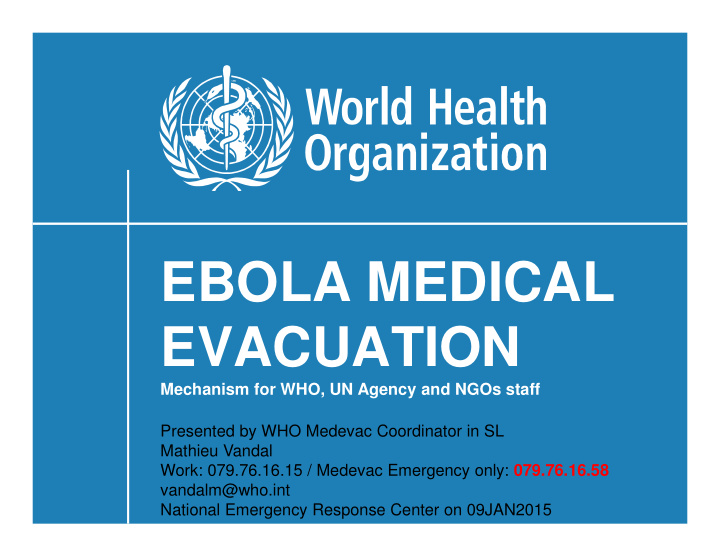



EBOLA MEDICAL EVACUATION Mechanism for WHO, UN Agency and NGOs staff Presented by WHO Medevac Coordinator in SL Mathieu Vandal Work: 079.76.16.15 / Medevac Emergency only: 079.76.16.58 vandalm@who.int National Emergency Response Center on 09JAN2015
LIMITATIONS: 1. Not for regular medical medevac (consult your organization HQ); 2. Medevac availability is not guaranteed, since capacity is limited; 3. All assistance provided shall be reimbursed by the requestor by the time specified in a promissory note signed by the requestor. The WHO is not financially responsible for the evacuation of patients that are deployed under the auspices of other organizations (UN agencies, IO, NGO). But EU has funds available . PRE-REQUISITE BEFORE REQUESTING MEDEVAC TO WHO: 1. Medical assessment and decision is provided by the medical point of contact (POC) of the requester (your NGO); 2. Formal authorization of medevac is granted by the requester’s HQ/National Team Leader in SL.
See PDF attached for details
WHO SL MEDEVAC 4 PHASES Normal everyday operations in which the conditions are set to receive a PHASE 0 STANBY request for medical evacuation support. Trigger: call for medevac. A partner organization decides to initiate a formal request to WHO , after having identifies an EVD case/suspect. Information is PHASE 1 REQUEST gathered. Decision is taken by WHO HQ/Geneva and confirmation is transmitted to WHO medevac coordinator in SL. Trigger: OK from Geneva . If necessary, patient is transferred to a local facility; treatment/care is provided; communications maintained with PHASE 2 ACTION partner’s HQ and field office; all documents are shared/signed, personal effects and passport is gathered; overall coordination maintained. Trigger: Ambulance departs for airport. Final land transportation of FINAL patient to airport is initiated (reverse countdown with ETA aircraft landing in SL). Phase ends when air evacuation medical crew takes control of the PHASE 3 MOVEMEMENT TO AIRPORT patient. (WHO/HQ Geneva will then take the lead with receiving country authorities and partner’s HQ).
Form will be sent to you when medevac request granted
What could be a high risk exposure*? • close face-to-face contact (1 m) without appropriate PPE (incl eye protection) with a probable or confirmed case who was coughing, vomiting, bleeding, or who had diarrhea; • direct contact with any material soiled by bodily fluids from a probable or confirmed case; • percutaneous injury (e.g. with needle) or mucosal exposure to bodily fluids, tissues or laboratory specimens of a probable or confirmed case; *FYI only; not an official definition endorsed by WHO.
WHO Statement on the 1st meeting of the IHR Emergency Committee on the 2014 Ebola outbreak in West Africa 8 August 2014 http://www.who.int/mediacentre/news/statements/2014/ebola-20140808/en/ Excerpt 1: “States should conduct exit screening of all persons at international airports, seaports and major land crossings, for unexplained febrile illness consistent with potential Ebola infection. The exit screening should consist of, at a minimum, a questionnaire, a temperature measurement and, if there is a fever, an assessment of the risk that the fever is caused by EVD. Any person with an illness consistent with EVD should not be allowed to travel unless the travel is part of an appropriate medical evacuation.”
WHO Statement on the 1st meeting of the IHR Emergency Committee on the 2014 Ebola outbreak in West Africa Excerpt 2: “There should be no international travel of Ebola contacts or cases, unless the travel is part of an appropriate medical evacuation. To minimize the risk of international spread of EVD: 1. Contact ( confirmed ) cases should immediately be isolated and treated in an Ebola Treatment Centre with no national or international travel until 2 Ebola-specific diagnostic tests conducted at least 48 hours apart are negative; 2. Exposure (which do not include properly protected health workers and laboratory staff who have had no unprotected exposure) should be monitored daily, with restricted national travel and no international travel until 21 days after exposure; 3. Probable and suspect cases should immediately be isolated and their travel should be restricted in accordance with their classification as either a confirmed case or exposure.”
Available if Available if questions questions Presented by WHO Medevac Coordinator in SL Mathieu Vandal Work: 079.76.16.15 /Medevac Emerg. only: 079.76.16.58 vandalm@who.int National Emergency Response Center on 09JAN2015 9 � ����������������������������������������� MoD UK Kerrytown 24/7 Duty Officer: 099.50.11.23
Recommend
More recommend